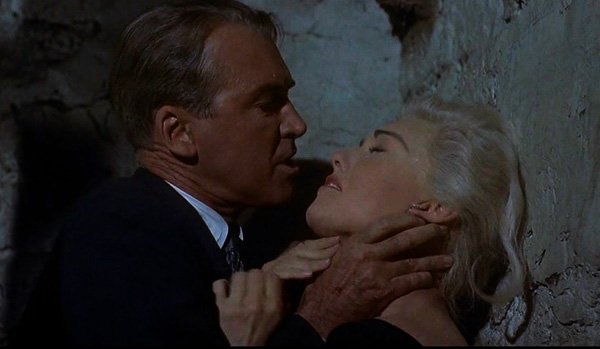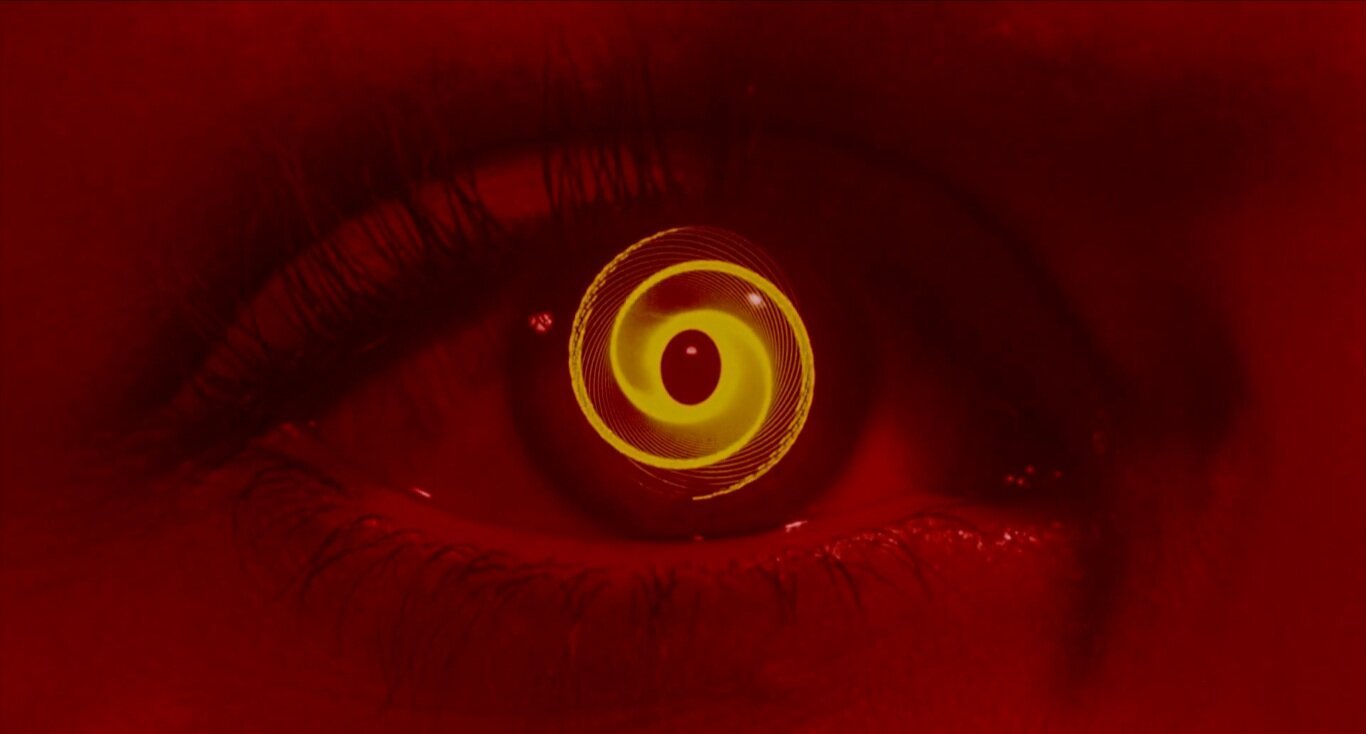
Vertigo
Made: 1958
Cast: James Stewart, Kim Novak, Barbara Bel Geddes, Tom Helmore
Director: Alfred Hitchcock
Screenwriter:
Cinematographer: Robert Burks
Producer: Herbert Coleman
"It's because I remind you of her."
"Judy, it’s you too!"
Vertigo is a movie about the pain of falling in love, and how it affects everything you do. The opening credits (created by master Saul Bass) reflect this with its constantly swirling spiral patterns and painful close ups of the human face. The main thing that is evident from the first scene is the color pallets and how each color represents a certain mood, from what shade the background is to what each character is wearing. Opening with an exciting rooftop chase scene, the remainder of the opening has a "relaxed" pace but also an epic quality from the vastness of the setting in San Francisco and the landmarks shown and mentioned like the tall redwood trees and the Golden Gate Bridge.
Vertigo is a dense movie, one that is filled with a mystery plot so intricate that you catch new things upon every viewing, and also it works as an almost silent film at times, with long stretches of no dialogue while characters secretly watch each other from afar. The movie has two distinct acts, with the first half as a murder mystery and the second act as an obsessive love story. Much has been made of how obsessed Scottie (James Stewart) becomes with remaking his lost love interest in his perfect image, but I have always been more enthralled with his nature as a detective to always find an answer. As Stewart says in the movie, “there is an answer for everything.” Scottie is a detective that was forced into retirement by the fact that during the opening chase for a robber on a rooftop, his fellow officer died by falling off a rooftop trying to save him. When an old friend named Gavin (Tom Helmore) hires him for one last detective job, Scottie agrees in an effort to still prove his worth as a human being. Unfortunately, things take a turn for the supernatural and complicate very quickly.
Yet there is no doubt that as endearing as the first half of the movie is, ending in a psychedelic dream sequence far beyond anything that had been attempted in a movie of such serious before in film history (full of animated flowers and stoplight flashes), the last part of the movie is the one that lingers in our memory. When Scottie finds his lost love’s doppelganger and Hitchcock lets us in on the surprise twist, the movie takes on new dimensions to say the least. Most directors wouldn’t dare such a twist in the middle of their serious drama, but the author Pierre Buille of the book Vertigo was based on (titled From Among the Dead) were fans of the director and wrote the story specifically for him to adapt into this movie, after a failed attempt to try and buy the rights to Diabolique several years prior. French Director Henri Clouzot adapted Diabolique instead and got many accolades for it; he was even dubbed “the new Master of suspense”, much to Hitchcock’s anger. In the book, the surprise twist comes at the end, but Hitchcock knew cluing the audience in on the secret without Scottie knowing would double the intrigue, and he was absolutely correct. Scottie becomes obsessed not with a mystery but with bringing past love back form the dead. Midge (Barbara Bel Gedes) is obsessed with Scottie the same way for the first half of the movie, following him around as a friend even though they used to be engaged and even getting jealous of a dead woman culminating in a bizarre portrait at one point that turns Scottie away from her.
Vertigo has its fair share of detractors in film criticism but is not, as some have bemused, a slow and bogged down movie with a bunch of loose ends. Some impatient people have targeted it that way, but Vertigo must have been shocking to audiences in 1958 and even fans of Hitchcock that expected fast thrills and easy to solve plot developments. The film was an odd mix of film noir, gothic horror, and romantic melodrama that had not been attempted before that gets better every time. The story is actually very focused and has only a few lead characters, with undercurrents of how people relate to each other as couples (making each other in their own images) and also constantly subverting the audience’s expectations. After trying to please audiences after the commercial failure of Vertigo with 1959’s carefree North by Northwest, Hitchcock would continue these darker themes in movies like Psycho, The Birds, Marnie, and Frenzy.
Repetition and reflection is the reason this movie works so well. Visual cues given by the director and cinematographer Robert Burke constantly give away secrets as to how Scottie figures out how he has been deceived. Hitchcock had wanted to use the famous “vertigo” staircase backwards-zoom going as far back as 1940’s Rebecca, but the technology did not exist then to make it possible; this camera effect has been copied many times in modern movies most famously in Spielberg’s 1975 film Jaws. They also used fog filters for flashback sequences in the churchyard and colors have never been used more effectively in any movie. The score by Bernard Herman is haunting and engrossing and it has never been equaled, even in his scores for Psycho and Martin Scorsese’s Taxi Driver.
How Hitchcock tells his stories is legendary, and it was a smart idea clueing the audience in on the secret identity of Madelyn (painfully acted by Kim Novak in her best ever role) and unlike most films, evil triumphs over good in many ways. Obsession leads to moral decay and the truth sometimes should not be revealed. It’s a weird story of true love and seeing through disguises that people wear. Emotions make us monsters and lead us to do things that are not healthy for us at all. When Madelyn asks Scottie "Can’t you like me? Just for who I am?" it’s a commentary on man's obsession with the way women look and what women have to do to please men in society. Hitchcock is often blamed for loving blondes and this film could be seen as a commentary on that fact itself, but in a way that the director was fully aware of; he was an auteur before Directors had earned that title. He also pushed the envelope within the ratings code for movies during the 1950’s, toying with ideas of necrophilia and dominance and actually getting away with it.
Alfred Hitchcock is the cinema’s most consistently good and greatest director, making over 50 films in his career and more than half of them are good to great in quality (think about that for a moment….that’s about 20-25 really great movies). He believed in “pure cinema” as pictures that do not need words. Vertigo is so dense it would work as a miniseries where more of its intricacies could be explored. More than any other movie ever made, Vertigo proves why cinema is powerful as an artform. It shows the true colors of people using colors of our souls. By being voyeurs, we can examine characters that at first seem alien, but also facing truths we do not want to realize about ourselves. Are we looking at these people as actors playing characters, actors playing themselves, or characters revealing something within actors?
Sidenote: The fact that Vertigo was not nominated for and did not win Oscars for make-up, Costume Design, acting, direction, photography, and Best Picture, is ridiculous. I can’t think of a picture that looks like more 1950’s America but not in a dated way at all. It was also a commercial failure in 1958, but is now considered the greatest picture ever made by the Sight and Sound Poll taken in 2012 ( the defining poll internationally taken every 10 years) above even Citizen Kane, 2001, The Godfather, etc. Time helps great movies.

